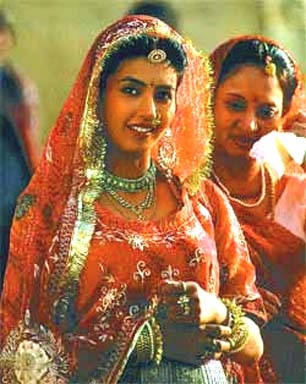Apr 15, 2025
Apr 15, 2025
 Wanted, an Indian bride. Only such hopefuls with the following pre-requisites need bother to apply: Tall, slim, fair (as in complexion), convent-educated, a working woman, a homemaker and, above all, 'homely' (Indi-speak for home-loving).
Wanted, an Indian bride. Only such hopefuls with the following pre-requisites need bother to apply: Tall, slim, fair (as in complexion), convent-educated, a working woman, a homemaker and, above all, 'homely' (Indi-speak for home-loving).
A tall order? Not at all, if advertisements in the matrimonial columns of India's major dailies are anything to go by. These would have us believe in a superwoman, a formidable deity raring to take on the challenging and often conflicting roles of super mom, glamour-doll, a professional, and a compassionate homemaker.
And, it is this very mythical being whom eligible bachelors and their parents in Indian society are increasingly seeking.
Indian marriages - arranged ones - are undergoing a major transition, given the impact of modernization on basic social values and institutions. Yet, even as modernity has promoted women's empowerment through education, legal reforms, political power and economic autonomy, gender discrimination is all too alive in the marriage market.
A new study looking at continuity and change in Indian marriage patterns over a period of 30 years brings up interesting insights on the perceptions and aspirations of young men and women and their families within the institution of marriage. The study, entitled 'Indian Marriages - Economic Independence & Changing Power Relations', analyzed matrimonial adverts in the Delhi editions of two prominent English newspapers, The Times of India and Hindustan Times, from 1967 to 1997. A randomly selected sample of 3,200 matrimonial adverts (1,600 inviting applications from potential brides and an equal number from grooms) was used for the study.
A significant change, the study reveals, is that the "pretty" and "virgin" bride sought after in the 1960s has given way to a specific female ideal with an emphasis on physical attributes and earning capabilities. In the 1960s, while caste and family were important, the girl's "merits" were the prime concern. Beauty was perceived more in terms of talents (like singing) rather than physical attributes; and "decent" marriages (implying dowry) were the norm, says Ranjana Kumari, the author of the study, and director of the Centre for Social Research, Delhi.
While education and caste considerations retained importance in the 1970s, "convent education" (a euphemism for 'English-speaking' women), and "smart" were words used in a fairly big way. Specific physical requirements such as height and "fairness" (light colored skin) were also mentioned in many adverts. The decade of the '70s also marked the emergence of the working woman, observes Ranjana.
The 1980s witnessed an increasing stridency of tone. Physical beauty - in terms of height and skin color - clearly started becoming very important, to the detriment of "accomplishments" or talents. Adjectives like "pretty" and "virgin" gave way to terms such as "tall and fair". Working women came to stay, and income (the higher the better) became a virtue to be flaunted. During this decade, men put great emphasis on their background, their family, and the part of the world they were settled in, or wanted to settle in.
Adverts in the 1990s demanded the professionally qualified, physically perfect working woman who was certainly not "pretty", says Ranjana. Paradoxically, though, as the desire for the "'90s woman" grew, there was also a growing yearning for the 'homely' daughter-in-law, chosen through a matching of horoscopes.
On the whole, physical attributes of the woman have been gaining importance throughout the period of the study, and acting as parameters of success in the marriage market.
For both men and women, more emphasis was placed on professional degrees in the 1990s. In a positive development, women are beginning to get specific about the kind of work their men should be doing. Besides, in adverts for grooms, the requirement of an "only son" has shown a growing trend. This suggests a kind of protection for the bride from living with the pressures associated with the power structures of an extended family. Also, in today's urban context, the fact that the family inheritance is sure to accrue to one's husband is a definite motivation, points out the author.
However, as far as what is required of brides, caste, region and family have retained their importance throughout the timeframe of the study. Caste has also remained an important consideration for grooms.
In the face of decline of the joint family, what is demanded of the potential bride (and her family) has become increasingly specific, and blatantly so. This trend has definitely perpetuated gender discrimination and double standards that are reinforced by globalization where the markets are flooded with luxury items which the bride's family is expected to gift in the garb of dowry.
So, has anything really changed - in terms of people's perceptions and how women are viewed - in the Indian marriage market? There is no doubt that the motivation to acquire a bride who has the 'right' physical attributes, can bring in money (whether through a job or a dowry), and generally promote consumerist bliss has intensified.
On the other hand, despite the growing accent on education and professional qualifications (in adverts for women or men), the straight and narrow tunnel vision on the role of a woman, caste and family background remains unchanged. If anything, the burden of expectations - on women - is heavier still.
31-Oct-2004
More by : Nitin Jugran Bahuguna